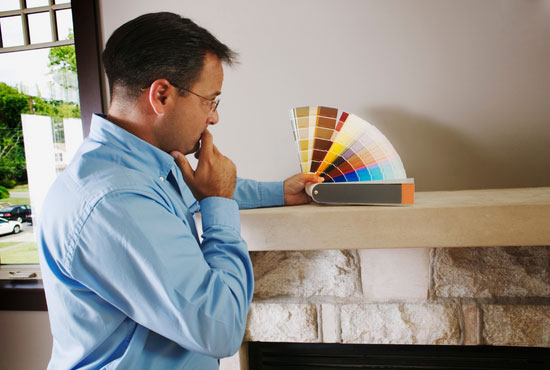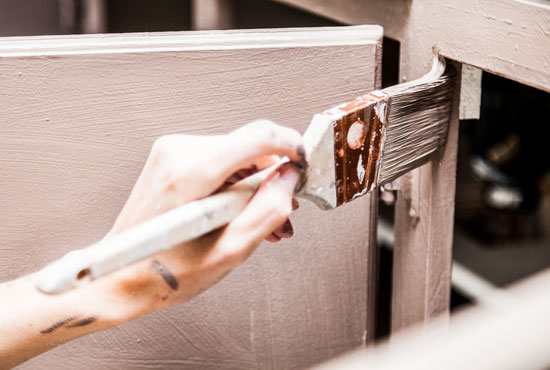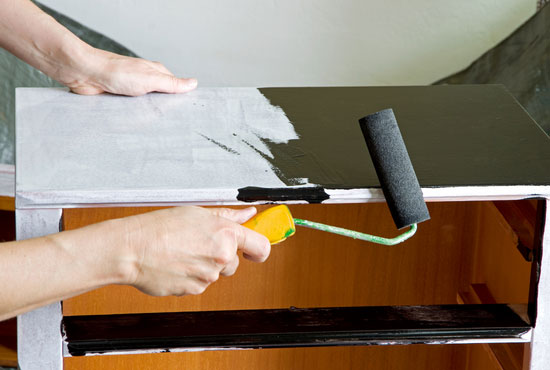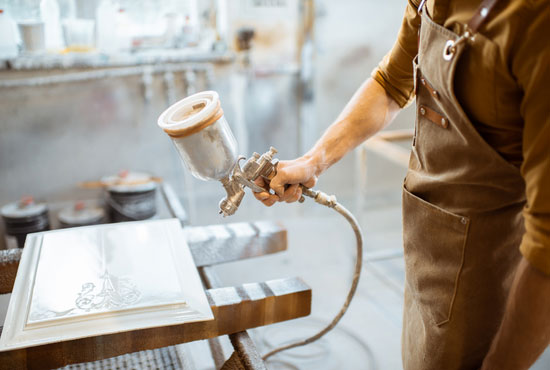In most homes, the kitchen is the central area where friends and family gather. We spend more time in our kitchens than we do in most of the other rooms of the house. The cabinetry in our kitchens set the tone for the rest of the room, and it came as no surprise to us when readers started to write us and ask how to get a smooth finish when painting kitchen cabinets.
We talked to interior design specialists and painters in our area to try and answer this question. We were thrilled when the experts gave us detailed advice on how to paint the cabinets, the supplies we needed, the things to avoid, and how they approached these painting jobs.
How to Get Smooth Finish on Painted Cabinets

Know The Kitchen Cabinet Basics
There are a few basic things that apply to all kitchen cabinets when you are considering painting them. These basics include:
- The surface areas must be cleaned with a degreaser and allowed to completely dry before you can proceed.
- The hardware, drawer pulls and hinges must be removed before you start to paint. (Always keep the screws with the piece of hardware it was removed from by using masking tape to tape the screw to the item. Then place all of the hardware in a large container with a lid or a zipper bag to keep it safe.) Label the pieces according to where they belong on the cabinets so you do not get confused later.
- Prepare the area by protecting your cabinet tops, your flooring, and anything in close proximity to the cabinets. Rosin paper is an excellent way to cover the countertops and stop paint from transferring to them.
- When you remove cabinet doors or drawer fronts be sure that you label them so you will know exactly where they go.
- Decide if you want the grain of the wood to show through the paint. Many wood grains, like the ones in oak woods, will show through the painted finish if you do not prepare the wood to block the grains. This can be accomplished using a high-grade primer in more than one coat, or by spackling the open grains so they do not show any longer.
- You must prime before you paint.
- When buying paint, you MUST have a semi-gloss or a high-gloss to withstand the continuous cleaning these surfaces will face.
- Give yourself plenty of time to finish the project. If you rush the job the finish will not be as good.
Read More>> How Long Does Floor Paint Take to Dry?
Choosing The Right Primer

When you paint in your kitchen you are painting in one of the areas of the home that sees the highest humidity levels. You must use a primer that stops mold and mildew from establishing a home in your home.
Your primer should also be able to hide stains that could already be present on the cabinetry and prevent future stains from happening.
The professionals recommend that you use an enamel underbody primer when you are painting in the kitchen, bathtub, or laundry room. The oil-based substance will dry slower than water-based ones but it also levels better and leaves a more attractive finish.
Choosing The Right Paint

As we said earlier, semi-gloss or high-gloss are the best choices for cabinet paint. Why? The semi-gloss paints are more resistant to damages like dents, and scratches, and that makes them more durable when used in kitchens and high-traffic areas in the home. When you are painting anything that is going to be frequently touched then think semi-gloss.
With that being said, the pros told us that if you are painting older cabinets that have slight imperfections you may want to consider a satin finish. The satin finish is better at hiding imperfections. They also say that if you choose to use a brush to paint your cabinets then you want to use a satin finish because semi-gloss paints are more likely to show the brush strokes than satin is. If you’re struggling to choose a color for your project, check out our color selection article.
Applying The Paint
After you have finished stripping the hardware and doors from the cabinets it is time to start painting. The first thing you should do is apply the primer. Primer usually requires only one coat, but in cases where the cabinet finish is rougher than you like, severely stained, or needs some imperfections to be hidden, then you may need to apply two or more coats of your protective primer.
Choose Your Application Methods to Paint Kitchen Cabinets for Smooth Finish

To paint your cabinets, you have to choose the application method you plan to use. Paint is generally applied by brush, roller, or spray gun. Canned spray paint is NOT an option for cabinets.
Painting Cabinets with a Brush
I cannot stress enough that painting cabinets with a brush is a bad idea. If you are dead set on using this application method then the following hints should help you get a better finish.
Step 1: Prepare the Surface
The surface needs to be prepared by cleaning and sanding before you paint. The sanding removes more of the old paint drips, rough finish, and small imperfections.
Step 2: Apply Primer
The primer needs to be applied and when it is totally cured you need to sand it slightly. Use a piece of fine-grit sandpaper and do this work by hand!
Step 3: Add Conditioner to the Paint
You need to buy a paint conditioner to mix with your paint. The conditioner actually helps reduce brush marks and roller marks. Do not try to save money by skipping this ingredient. The conditioner is a game-changer and gives you a better-looking cabinet when you are through.
Step 4: Use the Right Brush
Make certain you have purchased a high-quality paintbrush for the work. Choose an angled brush that is about 2 to 21/2” and you want a brush that has a short handle. The short handle is going to make it easier to apply paint to the interior sections of the cabinet.
You need a smaller brush of the same quality for use on trim and in narrow areas.
Step 5: Applying The Paint
You do not want to try and apply too much paint at one time. You are more than likely going to have to do a second or third coat. You apply the paint in thin coats that dry quickly. Thin coats are easier to keep from having brush marks.
Your touch must be light so do not push the brush against the surface. The brush should glide smoothly over the area. Take your time and rest your arm if you start to tire. It is natural to want to just push through when you start to tire but the work you do when you are tired will not be as good as the work you do when you are rested.
Other Tips
- Paint the backside of the doors before you paint the fronts!
- The doors need to be in a horizontal position when painting and while they are drying
- Do not try to speed the process with a fan. Fans stir dust into the air and that dust can mar the finish.
- Never try to apply the second coat before the first coat has TOTALLY cured. Forget what the can says about applying a second coat while the paint is merely “dry to the touch”. If you want a smooth and flawless finish the paint needs to dry totally before another coat is added.
Painting Kitchen Cabinets with a Roller

Using a roller is a better way to get a smooth finish on your cabinets. You need to make sure to have rollers that are the proper size for the project. You do not want to use a roller that is wider than the cabinet section, and you do not want to use a roller that is so narrow that you have to cover the section repeatedly to paint the entire thing.
1. Prepare The Surface
Prepare the surface for painting just like you would prepare it if you were using a brush.
2. Apply The Primer
Apply the primer just like you would when using a brush. You can skip the sanding of the primer after it dries if you use a roller instead of a brush.
3. Choose The Roller Cover
Use the right roller cover. The foam roller covers actually do very well on smooth surfaces like cabinet doors and shelves. They leave fewer marks, and they apply a thinner coat of paint so the finish is more attractive. If you’re struggling with roller painting streaks, check out our dedicated article on the topic.
4. Use A Conditioner
Even if you are using a foam roller there is a chance of leaving roller marks. Go ahead and invest in the conditioner and reduce the chances of marks as much as possible.
5. It is Time to Paint
When you get ready to paint the surface do not overload the roller. You want uniform coverage and you need to be prepared to paint the surface with more than one coat. It normally takes at least two coats of the top color to create the perfect coverage you desire.
Other Tips
- Never paint when the outside temperature is below 350 F.
- Throw away the foam roller cover rather than trying to wash it and reuse it
- Never put the second coat of paint on before the paint is totally cured
- Always paint doors in a horizontal position
Painting Cabinets with a Spray Gun for Better Finish

If you want the perfect finish on your cabinets then the spray gun is the right applicator. The spray gun may not be a good choice if the cabinets have to be painted in place, or if you cannot take the sections of the cabinets like the doors outside.
Painting with a spray gun requires more preparation because the overspray from the gun can transfer paint to other areas of the room. Take your time and cover everything with plastic sheets, painter’s tape, and cardboard.
You MUST use a piece of cardboard and do a practice paint spray to determine if the sprayer is set up to provide you with a smooth paint coat that does not run or drip. This is also the time when you make sure you have chosen the right tip and your skills are sufficient to allow you to apply the paint in a consistent method.
You can thin your paint for the spray gun using a paint conditioner. You can also thin it using water for water-based paints and paint thinner for oil-based paints.
Spray thin coats and you can start repainting with the next coat when the paint is “dry to the touch.” Spray guns apply a thinner coat so that when they are dry to the touch they are dry enough to accept a second coat.
Frequently Asked Questions
Is It Better to Roll or Brush Paint Cabinets?
When you are painting high-profile items like cabinetry you want to use a roller to apply the paint or a spray paint gun. Brushes leave lines and marks that take away from the beauty of the cabinet. Rollers apply paint faster and leave a smooth and uniform finish.
What Is The Best Paint Finish for Kitchen Cabinets?
Most professional painters and interior designers recommend semi-gloss paint for cabinets. The semi-gloss paints are more suitable for the frequent cleaning and scrubbing that cabinetry requires. You can also use a high-gloss. High gloss is sturdy and can be cleaned often but it is also more light-reflective and will cause the cabinet to appear shiny.
Can I Paint Over Cabinets That Are Already Painted?
You can paint a cabinet that has already been painted. You should clean the surface of the cabinets thoroughly to remove all grease, dirt, or grime. Then check the smoothness by touching the cabinets to see if you need to sand them. Finally, remember that you have to use a primer before applying the topcoat of paint.
Final Word
You can paint your kitchen cabinets and have them look fabulous, but you must take your time, and use the right paint and the right paint applicator. When you start a kitchen remodel project like painting the cabinetry remember that your kitchen will be a little upside down for a bit so plan meals that do not require a lot of cooking or cleaning up after.
Your home is your refuge, so decorate it in colors and styles that make you happy, and do not worry about what is trending or what anyone else might think about your choices.
